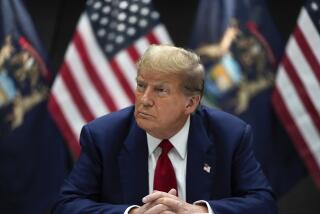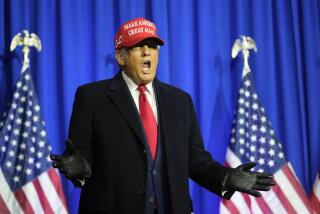Economic reality and contradictions beset Trump’s tax plan

Trump wants to enact a tax reform of historic proportions. (April 27, 2017) (Sign up for our free video newsletter here http://bit.ly/2n6VKPR)
In proposing to slash business taxes and enact a tax reform of historic proportions, Trump administration officials say they will rely largely on economic growth to make up for the trillions of dollars of lost tax revenue.
But hardly any economist or tax policy analyst outside the administration thinks that the core business piece of President Trump’s plan — a reduction in the corporate income tax rate to 15% from the current 35% — will generate anywhere near the growth, job creation and investment needed to pay for itself.
That economic reality makes it highly unlikely that Trump will be able to get his tax proposal in its current form through Congress, even with support from his fellow Republicans. And it exposes some inherently contradictory elements in the president’s approach.
Trump’s tax blueprint unveiled Wednesday is similar to the plan he outlined during the campaign last fall. It’s a grab bag of long-sought Republican tax reform ideas, including eliminating most individual deductions, killing the estate tax and ending the alternative minimum tax, which seeks to ensure the rich can’t exploit loopholes.
But the ambitious proposal is another example of how Trump’s transactional, compartmentalized approach to achieving his priorities — whether repealing Obamacare, reforming taxes or cracking down on immigration — often works at cross-purposes.
Economic experts say, for example, that his immigration crackdown plan may do more to dampen economic growth than the tax cuts will do to promote it.
The failure to find a way to pay for his tax cuts will likely increase the national debt significantly and therefore worsen the U.S. trade deficit he’s vowed to reduce.
And pushing forward so quickly with a tax reform plan may bolster his 100-day report card, but by not first securing a healthcare overhaul or embracing the House GOP’s proposal for a border-adjustment tax on imports, convincing congressional deficit hawks to approve his tax plan becomes all the more difficult.
“I think this is a total disconnect in the administration,” said Marc Goldwein, a senior vice president for the Committee for a Responsible Federal Budget, a nonpartisan group that advocates keeping government budgets under control.
The committee estimated that the Trump tax plan would cost Uncle Sam roughly $5.5 trillion over 10 years — mostly from the cuts in business taxes — and add more than $6 trillion to the national debt. Other tax experts said there wasn’t enough information on the Trump plan to calculate potential revenue losses, but some also see the gap in the trillions of dollars over the next decade.
A lower corporate tax rate would give a bump to economic growth, of course, as would Trump’s proposal to shift to a “territorial” system in which U.S. companies are not taxed for foreign profits, said Joe Kennedy, a senior fellow at the Information Technology and Innovation Foundation and former chief economist at the Commerce Department. Nonetheless, Kennedy said the plan was absent of key measures to boost productivity and competitiveness, such as tax credits for research and development and faster depreciation for capital expenditures.
In unveiling Trump’s tax plan, Treasury Secretary Steven T. Mnuchin said that the aim was to simplify taxes, boost growth and help companies become more competitive. Some of the shortfall in corporate tax revenue would come from curbing breaks for special interests, he said, and on the personal income tax side, from the elimination of all deductions except for mortgage interest and charitable contributions.
“We have over 100 people in the Treasury that have been working on tax and scoring lots of different scenarios,” he said in a White House briefing Wednesday with Trump’s chief economic advisor, Gary Cohn. “This will pay for itself with growth and with reduction of different deductions and closing loopholes.”
Mnuchin insisted that the tax plan would unleash much more business activity, driving economic growth to an annual rate of 3% or higher on a sustained basis, from the 2% level of the last decade and projected over the next decade. Trump’s policies to ease business regulations and renegotiate trade agreements would add to growth as well, he said.
Mnuchin did not provide any revenue estimate of the tax proposal, but the administration’s confidence that the tax cuts would not add to the federal debt presumably stems from the notion that economic growth would offset the cost of the tax plan, under assumptions that make up what is called dynamic scoring.
As a rule of thumb, every 0.1-percentage-point increase in the growth of economic output, or gross domestic product, would generate about $250 billion in tax revenue over 10 years.
The Congressional Budget Office’s latest budget outlook, in March, forecast GDP growth averaging 1.9% a year from 2017 to 2027, similar to most private forecasts and others, including that of the Federal Reserve. If Trump could lift average growth to 3%, that would add some $2.8 trillion in additional tax revenue over 10 years — which would largely pay for Trump’s corporate tax cut plan.
But most economists and budget experts say that’s not realistic. GDP growth is essentially a function of labor force and productivity trends, and both have lagged in the last decade, particularly with the retirement of the baby boomers and declining birth rates, which are slowing growth in the workforce.
“Tax reform can help us build more capital, encourage people to work more hours, in some cases increase productivity,” said Goldwein of the Committee for a Responsible Federal Budget. “But demographics is really what has been driving the major swings in growth rates, and tax reform can’t stop an aging population.”
“There’s been a lot of dynamic scoring done in this town, but we’ve never seen any tax proposal pay for itself,” said Douglas Holtz-Eakin, a former Congressional Budget Office director who is president of the conservative-leaning American Action Forum. He said it’s possible that about one-fourth or one-third of the cost of tax cuts could be recouped with faster GDP growth, but others think even that would be very hard to achieve.
The gap between the cost of the plan and tax revenue it would likely generate poses a huge challenge for the administration as it tries to push the plan through Congress without having to secure Democratic support by using something called reconciliation. One requirement of that budget process, which allows Senate passage with a simple majority, is that the tax change would not add to the deficit after 10 years.
President George W. Bush got around that obstacle by ensuring that his own tax-cut plan expired after 10 years.
But a senior tax counsel to the House Ways and Means Committee recently indicated that the Trump tax plan — with its emphasis on corporate tax rates — would add to the deficit beyond 10 years, even if the business tax cuts expired after three years. Such short-term cuts would do little to spur businesses to invest and grow.
And if such an analysis is accepted by lawmakers, it will make it much harder for Trump to pass the plan through the reconciliation process.
Twitter: @dleelatimes
ALSO
White House will continue Obamacare payments, averting potential obstacle in talks to avert shutdown
Trump signs order to reconsider national monuments created by Obama, George W. Bush and Clinton
White House announces sweeping proposal to cut taxes, a plan likely to raise deficit







